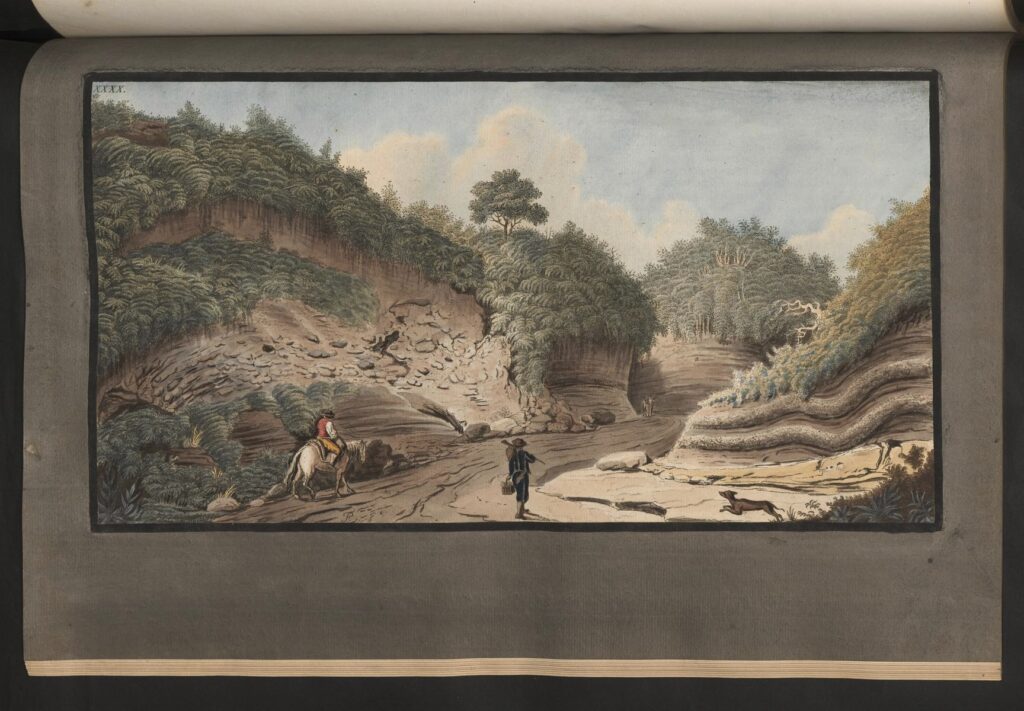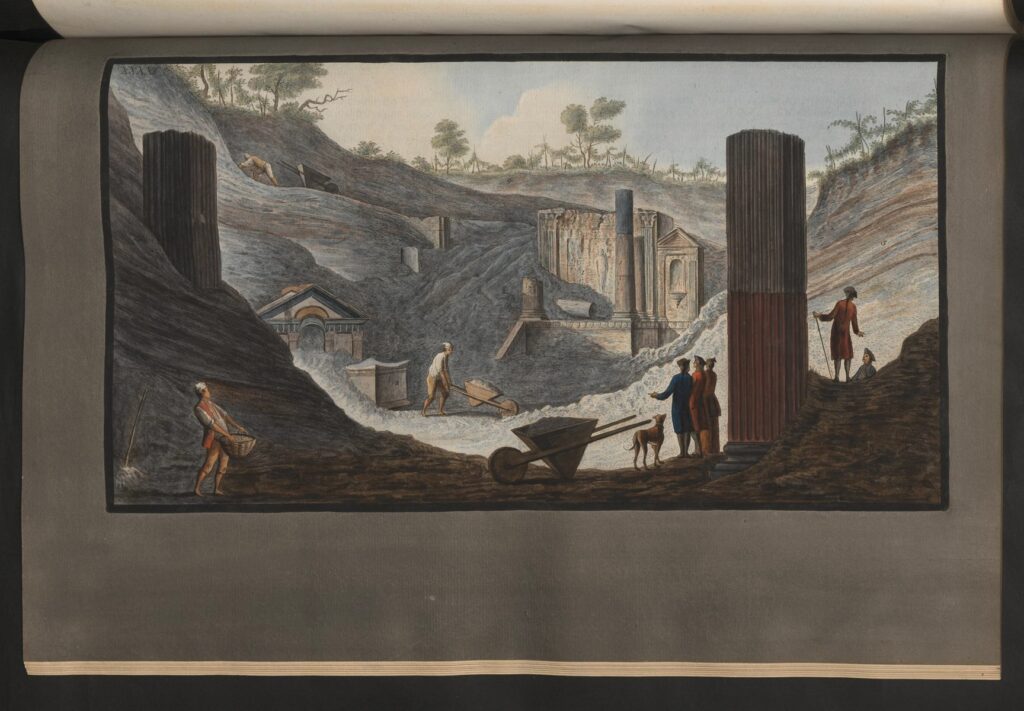William HAMILTON, Campi Phlegraei. Observations on the Volcanoes of the Two Sicilies, as they have been communicated to the Royal Society of London by Sir William Hamilton K. B. F. R. S. His Britannic Majesty’s envoy extraordinary…, Napoli, Pietro FABRIS (editore nel senso di venditore esclusivo), Francesco MORELLI (stampatore) 1776. Tavole XXXX e XXXXI. Acqueforti colorate a mano (in genere ad acquerello), cm. 39 x 21,5. Autore delle gouaches originali: Pietro FABRIS. Incisore: Pietro FABRIS ?
La tavola XXXX rappresenta la stratigrafia visibile lungo la strada tra la grotta di Posillipo e Pianura. La tavola XXXXI rappresenta la stratigrafia svelata dalla scoperta del tempio di Iside a Pompei. Verso sinistra, lungo il margine inferiore della tav. XXXX, sono visibili le iniziali di Pietro Fabris: “FP”. Visibili anche in altre tavole (ad esempio IV e XVI, in basso a destra), potrebbero indicare che almeno in questi casi Fabris fu anche l’incisore (Jenkins e Sloan 1996, p. 167).
Bibliografia. Sulla attribuzione delle incisioni a Fabris cf. Knight 2000, p. 34; Doria e Ferrari 1957, pp. 15-16. Sulle vicende editoriali e le tecniche esecutive: Knight 2000, in part. pp. 34-35; Jenkins and Sloan 1996, in part. pp. 165-7; Wood 2006.
TEORIE
Geologia e archeologia.
Teoria globale.
Scopo delle due tavole è dimostrare che non solo il Vesuvio, ma l’intera area intorno a Napoli ha origine vulcanica, secondo una visione tendenzialmente globale del vulcanesimo. Hamilton utilizza gli scavi in corso a Pompei (dal 1748) per dimostrarlo. Le fonti antiche attestavano che Pompei venne sepolta da una eruzione vulcanica. Conseguentemente la somiglianza tra i materiali che ricoprivano Pompei e quelli visibili in altre aree della Campania implicava una analoga origine vulcanica di queste ultime.
[p. 53]…the whole circuit (so far as I have examined) within the boundaries marked in the map, is wholly and totally the productions of subterraneous fires…[p. 54] To begin with some degree of order…I will first mention the basis on which I found all my conjectures. It is the nature of the soil that covers the ancient Towns of Herculaneum and Pompeii…with the sort of the materials of which it is composed. It cannot be denied, that Herculaneum and Pompeii stood once above ground, though now the former is in no part less than seventy feet, and in some parts one hundred and twelve feet below the present surface of the earth; and the latter is buried ten or twelve feet deep [p. 55] more or less. As we know from the very accurate account given by Pliny the younger to Tacitus, and from the accounts of other contemporary Authors, that these Towns were buried by an eruption of Mount Vesuvius in the time of Titus…
ROCCE E DEPOSITI
Paleosuoli
Depositi piroclastici
Stratigrafie
La tav. XXXXI rappresenta il fertile terreno moderno sovrapposto ai depositi piroclastici (pomici, lapilli, ceneri etc.) che sommersero Pompei:
3. Strata of white pumice stones, and other volcanick matter.
4. Stratum of good vegetable soil on which vines grow (Didascalia della tavola).
La tav. XXXX, oltre a questa stratigrafia (indicata, su ambo i lati, con “1” (lapilli) e “2” (ceneri e frammenti di lava), sembra rappresentare a destra l’alternanza di strati di lapilli e terreni antichi o “paleosuoli” (lo strato con il terreno fertile moderno è indicato con “4”: Stratum of loose volcanick matter with a stratum of vegetable earth on its surface). Hamilton fu tra i primi a riconoscere l’esistenza dei paleosuoli.
[p. 56] Upon examining the cuts and hollow ways made by currents of water in the neighbourhood of Vesuvius and of other Volcanos, I had remarked that there lay frequently a stratum of rich soil, of more or less depth between the matter produced by the explosion of succeeding eruptions; and I was naturally led to think that such a stratum had grown in the same manner as the one above [p. 57] mentioned over the pumice of Pompeii…Whenever I find then a succession of different strata of pumice and burnt matter, like that which covers Pompeii, intermixed with strata of rich soil…I hope I may be allowed reasonably to conclude that the whole has been the production of a long series of eruptions, occasioned by subterraneous fires.
Domenico Laurenza


